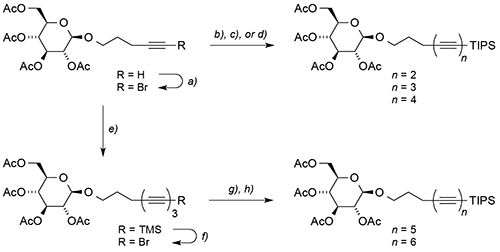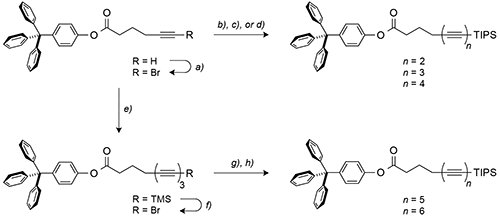Carbon-rich organic compounds containing a series of conjugated triple bonds (oligoynes) are relevant synthetic targets. Oligoyne derivatives have been found in a variety of natural products are under consideration as molecular wires, show intriguing non-linear optical properties, and have recently been used as molecular precursors for the preparation of carbon nanomaterials at room temperature. In this context, an improved access to oligoynes bearing chemical functional groups is desirable. We have developed a heterocoupling protocol based on the Negishi coupling that allows us to readily prepare unsymmetric oligoyne derivatives on the multi-gram scale. The required zinc acetylide are prepared in situ from stable trimethylsilyl derivatives and are coupled with bromoacetylenes to yield the desired heterocoupling products in high yields. Repeated bromination and Negishi coupling sequences then readily furnish higher oligoynes bearing chemical functional groups such as the carboxylate or glycoside groups in few synthetic steps. The obtained oligoyne derivatives can moreover be deprotected to yield the corresponding amphiphiles. Hence, we have developed the tools to access and handle oligoynes derivatives with labile functional groups despite their inherent chemical reactivity, which may in turn be utilized for the further preparation of carbon-rich compounds or nanomaterials.
- S. Schrettl, C. Stefaniu, C. Schwieger, G. Pasche, E. Oveisi, Y. Fontana, A. Fontcuberta i Morral, J. Reguera, R. Petraglia, C. Corminboeuf, G. Brezesinski, H. Frauenrath, Functional Carbon Nanosheets Prepared from Hexayne Amphiphile Monolayers at Room Temperature, Nature Chem., 2014 , 6, 468-476,
- T. N. Hoheisel, H. Frauenrath, A Convenient Negishi Protocol for the Synthesis of Glycosylated Oligo(ethynylene)s, Org. Lett., 2008 , 10, 4525-4528
- T. N. Hoheisel, H. Frauenrath, Glycosylated Oligo(ethynylene)s via a Pd/Zn-Mediated Cross-Coupling Reaction, Chimia, 2009 , 63, 208-210
- S. Schrettl, E. Contal, T. Hoheisel, M. Fritzsche, S. Balog, R. Szilluweit, H. Frauenrath, Facile synthesis of oligoyne amphiphiles and their rotaxanes, Chem. Sci., 2015 , 6, 564–574,

a) AgNO3, NBS, MeCN, 93%;
b) TIPS-C≡C-ZnCl, PdCl2(dppf) ⋅ DCM, THF/toluene, 87%;
c) TIPS-(C≡C)2-ZnCl, PdCl2(dppf) ⋅ DCM, THF/toluene, 78%;
d) TIPS-(C≡C)3-ZnCl 3, PdCl2(dppf) ⋅ DCM, THF/toluene, 51%;
e) TMS-(C≡C)2-ZnCl, PdCl2(dppf) ∙ DCM, THF/toluene, 72%;
f) AgF, NBS, MeCN, 81%;
g) TIPS-(C≡C)2-ZnCl, PdCl2(dppf) ∙ DCM, THF/toluene, 42%;
h) TIPS-(C≡C)3-ZnCl 3, PdCl2(dppf) ∙ DCM, THF/toluene, 55%.

a) AgNO3, NBS, DCM/MeCN, 96%;
b) TIPS-C≡C-ZnCl, PdCl2(dppf) ⋅ DCM, THF/toluene, 68%;
c) TIPS-(C≡C)2-ZnCl, PdCl2(dppf) ⋅ DCM, THF/toluene, 51%;
d) TIPS-(C≡C)3-ZnCl, PdCl2(dppf) ⋅ DCM, THF/toluene, 65%;
e) TMS-(C≡C)2-ZnCl, PdCl2(dppf) ∙ DCM, THF/toluene, 71%;
f) AgF, NBS, DCM;
g) TIPS-(C≡C)2-ZnCl, PdCl2(dppf) ∙ DCM, THF/toluene, 59% over two steps;
h) TIPS-(C≡C)3-ZnCl, PdCl2(dppf) ∙ DCM, THF/toluene, 44% over two steps.